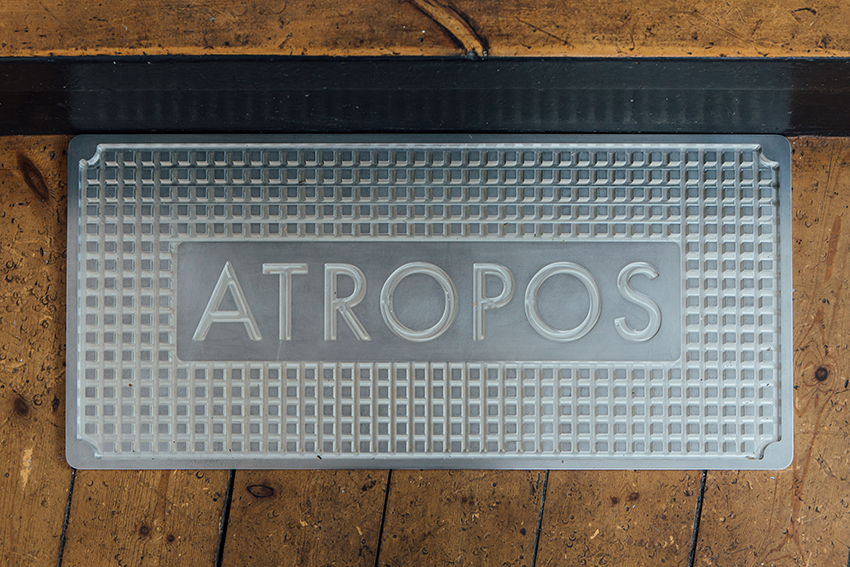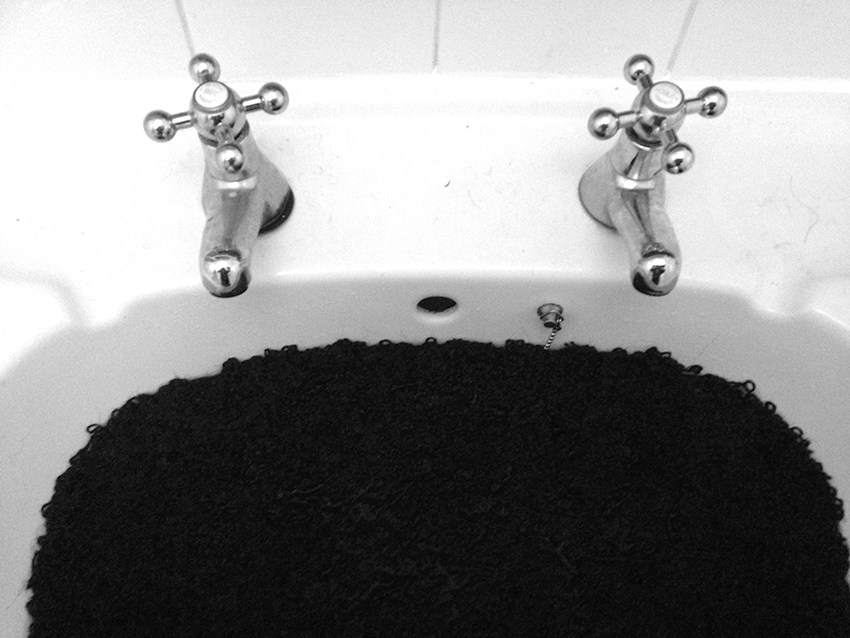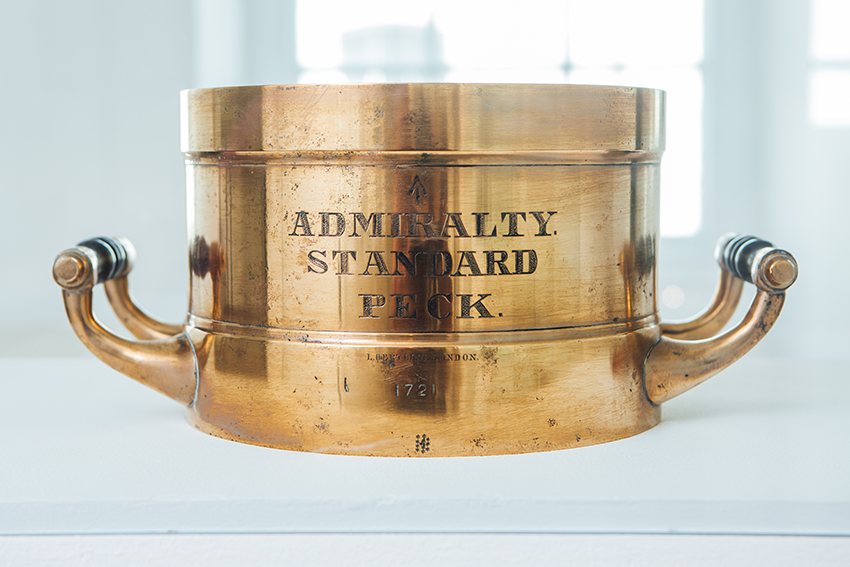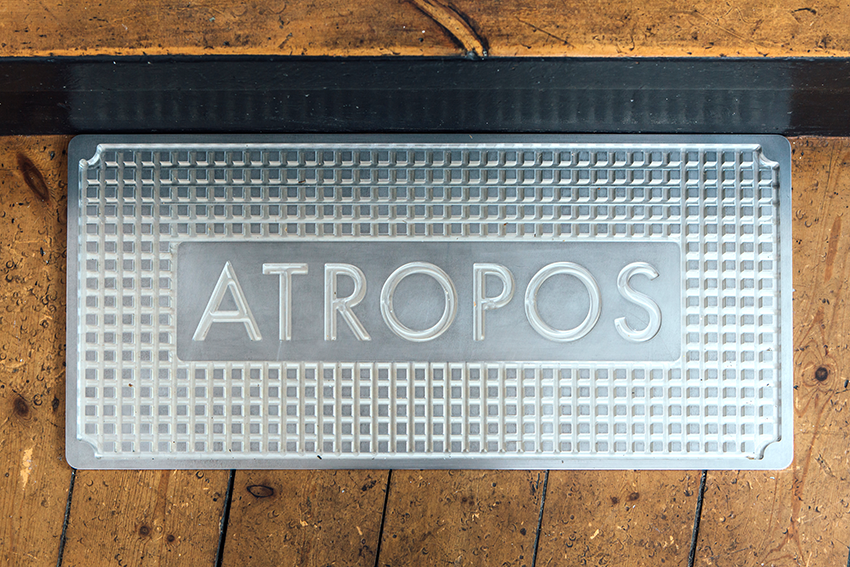
Tanks & Tablecloths is an ongoing collaboration between myself and Elizabeth Masterton, begun in 2004. [For more information about this collaboration, please see Tanks & Tablecloths: Chapter One.] |
Tanks & Tablecloths: Chapter Two explored the archives of Devonport Naval Heritage Centre (DNHC), relocating original artefacts and presenting these alongside new works in the gallery of Plymouth Arts Centre. The exhibition was a test-ground for our experimental concept of ‘an exploded book’: an attempt to define how a work might be ‘read’ in space, using four-dimensional inter-relationships between text, subject and object. | DNHC holds a military collection which records the development of the dockyard and Plymouth’s role in the Royal Navy. It houses a large collection of ‘victualling’ artefacts from the Royal William Yard in Stonehouse. This vast facility, designed by Sir John Rennie and completed in 1831, became the major provisioning, or ‘victualling’, depot of the Royal Navy. Supplies for the Royal Navy were stored at the Yard, including equipment, food rations and clothing.
|
From our first visits to DNHC, we were struck by the quantity of items that established consistency, systematization and uniformity: from mess utensils regulating portion sizes, to photographs documenting damage to ships from enemy fire. In response, the curation of artefacts and new works is framed by these notions of measuring, quantifying, delineating and assessing, symbolised in the exhibition by the ancient Greek myth of the Fates, or Moirai. These three female deities were charged with spinning, measuring and cutting the thread of life. The exhibition was organised within these jurisdictions: Clotho, the Spinner; Lachesis, the Allotter and Atropos, the Unturning. Each of the three sections of the exhibition was demarcated by a specially created 'treadplate', depicting the name of the deities, referencing the ship's treadplates in the DNHC collection. The exhibits in each space examined the themes associated with that given Fate. | Through a process of reduction – both literal and semantic – we interrogated the materials, processes and words used in the responsive works, paring down to their essential properties or etymology. Belli Dura Despicio [Broadside] considers the multiple meaning of the word ‘broadside’, as a description of a position, an action, a measurement and a print-term. In its complete edition of 150 broadside newsprint sheets, Belli Dura Despicio [Broadside] is a 29.7km line printed on 150 broadside newsprint sheets. 29.7km relates to the maximum distance of a broadside from Warspite's 15" guns (in this instance a broadside refers to a firing of all the guns from one side of a warship).
|
The Measure of a Man series of works took the concept of the ‘average man’ to develop a series of unconventional metrics for describing the human body. The wool from a standard ex-Government naval jumper was re-spun into rope (referencing Devonport’s historic ropery); the amount of salt present in the average male was extracted using a process of rapid evaporation from seawater gathered in Plymouth Sound. The process of making the works and the time invested in their creation was as important as the finished pieces themselves, and the passage of time made visible in some of the works designed to tarnish and corrode during the period of the exhibition.
|
While making the film Quercus Regius: 00:58-01:29 in the darkroom, the artists assumed the roles of the Fates, blindly unravelling, measuring and cutting the unwound wool from the previously mentioned ex-Government naval jumper, and placing it on light-sensitive film, the animated duration of which corresponds to that of the sinking of HMS Royal Oak (the warship was built in Devonport). | In keeping with the theme of measuring, displayed in the Atropos space, but also refering to the collection of Hurt Books in Lachesis, was our own interpretation of a Hurt Book. The Hurt Books from Devonport record health and safety incidents at the docks, both major and insignificant. Handwritten, they form a document of the volume human of damage on site. Our interpretation of this material was a Hurt Book of our own, measuring the cutting capabilities of DNHCs knife collection. Each knife on display was used to attempt to cut a sheet of paper. Many were ineffective, merely leaving scores, rustly lines or partial cuts. Hurt Book is a book documenting these (inconsequential) incisions.
|
This exhibition was a rare opportunity to see DNHC archive items outside the archive, where pre-booking is required. For further details on DNHC open days and booking details, visit www.devonportnhc.wordpress.com For more information about Tanks & Tablecloths: Chapter Two, please visit our blog tanksandtablecloths.blogspot.co.uk
|
Credits & thanks For their generous support in terms of time, equipment, knowledge and expertise: Nicola Dowding and Ray Crockett at Devonport Naval Heritage Centre for their generosity in allowing us full access to the DNHC archive; all the volunteers at Devonport Naval Heritage Centre but particularly Keith Johnson, Paul Santillo, Bob Cook and David Boden for their time and helpful insights into archive items; Drummond Masterton for CNC milling of Clotho, Lachesis and Atropos; Paul Ridout for all his work editing and sequencing Quercus Regius: 00:58-01:29; Jean Fenton at Kaeravel Krafts for her expertise in all things wool and for spinning our thread ready for rope-making; Tessa Wannell and staff at Morwhellham Quay for helping us make the rope; Oliver Udy at Plymouth University for his help in the darkroom; Vickie Fear, Caroline Mawdsley, Steve Mitchell and Ben Borthwick at Plymouth Arts Centre for their help in producing this show; Tim Mills at Plymouth History Festival for first putting us in contact with DNHC; Cornwall Ladies Auxilliary (West) for knot-tying; South West Film & Television Archive for loan of film equipment; Peninsula Arts for loan of plinths and Estates at Plymouth University for plinth porterage; Owen Ryles for his introduction to Plymouth Athenaeum; James Jobling-Purser and Gus Williams at Holman’s Test Mine, University of Exeter for explosives advice. Finally we would both like to thank our ever-patient and supportive families. |
| The three gallery spaces: Clotho, Lachesis & Atropos | Atropos (The Unturning) Treadplate [CNC milled aluminium sheet] | Lead footprint [From a diver’s suit]. Believed to be 1940 but no accurate records |
Combed Tops [Samples of wool ‘tops’ used for spinning yarn]. Date unknown |
The Measure of a Man I (4 Fathoms) [Wool from one disassembled navy surplus pullover, spun into rope] | Creation of The Measure of a Man I (4 Fathoms) | The Measure of a Man II (For Herbert) [Electroformed copper feather, equivalent weight of coal grains on hanky] | 50000 x 1 mm wound Helios wool from naval jumper & 35mm orthographic film 9400 x 35mm wound film | Things That Were / Things That Are / Things That Are To Be [CNC Engraved Traffolyte] | Exhibition guide pages | Lachesis (The Allotter) [CNC milled aluminium sheet] | Brass Measures. Dated from 1721 | Hurt books I, II, II. Dated 1888–1891, 1902–1903, 1913–1914 | Set of Scales | Rations [Vacuum packed foodstuffs]. Believed to be 1971 but no accurate records |
Graf Spee, gun barrels I, II [Digital prints from original glass negative]. Date unknown |
The Republic of Plato & Seagull Feather | The Measure of a Man III (Worth His Salt/Test His Mettle) [350g of Plymouth Sound sea salt on brass] | The Measure of a Man III (Worth His Salt/Test His Mettle) [350g of Plymouth Sound sea salt on brass] | Creation of The Measure of a Man III (Worth His Salt/Test His Mettle) | Atropos (The Unturning) [CNC milled aluminium sheet] | Knives. 1930s-1950s | HMS Athabaskan (damage by glider bomb), I, II, III [Digital prints from original glass negative].1943 |
Shears, used for manually cutting metal [Steel]. Believed to be 1950s but no accurate records |
Shears, used for manually cutting metal [Steel]. Believed to be 1950s but no accurate records | Quercus Regius: 00:58-01:29 [Digital film, black & white, 31 minute loop] | Quercus Regius: 00:58-01:29 [Digital film, black & white, 06:51 minute edited version] | Hurt Book [Digital print and various cuts, on Fabriana Liscia 160gsm & Revive Recycled Gloss 115gsm, stitch-bound] | Belli Dura Despicio (Broadside) [29.7km line on 150 broadside sheets. Digital print on 55 gsm newsprint] | Belli Dura Despicio (Broadside) [29.7km line on 150 broadside sheets. Digital print on 55 gsm newsprint] |





























